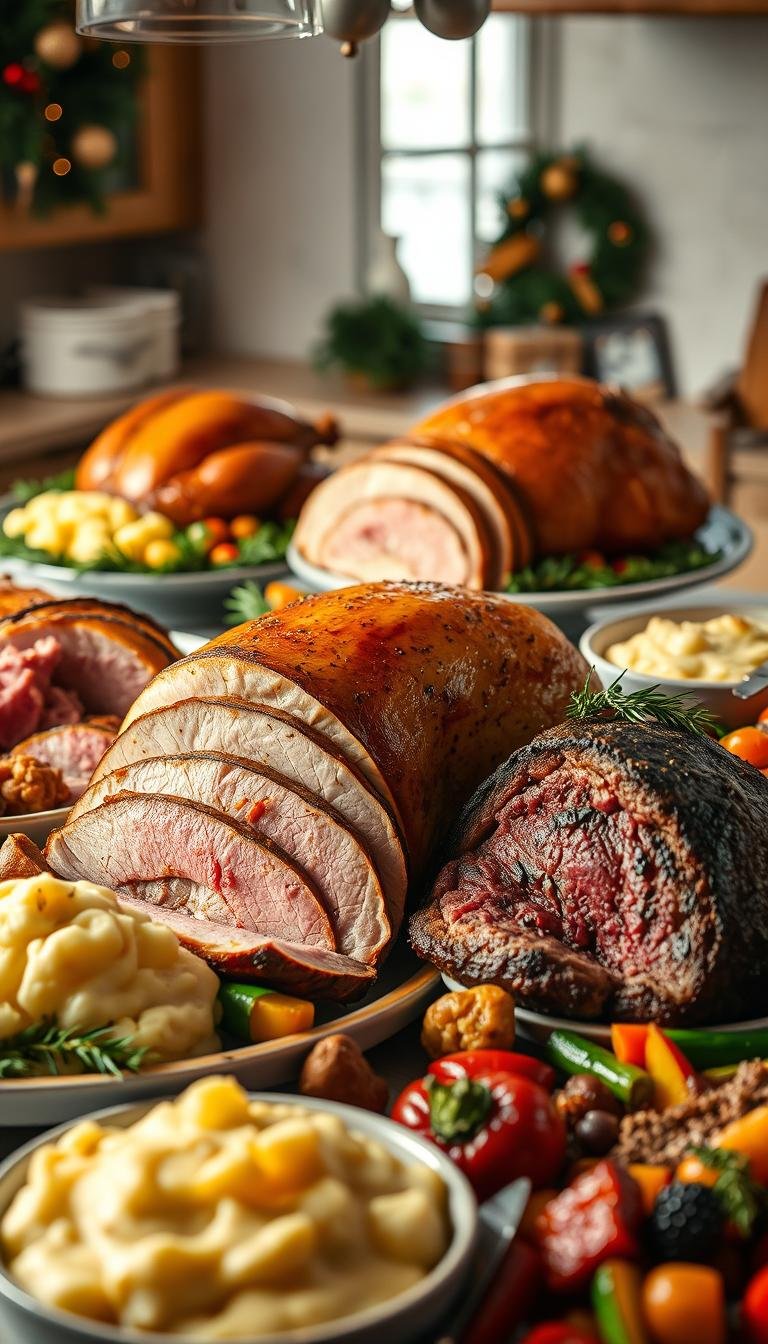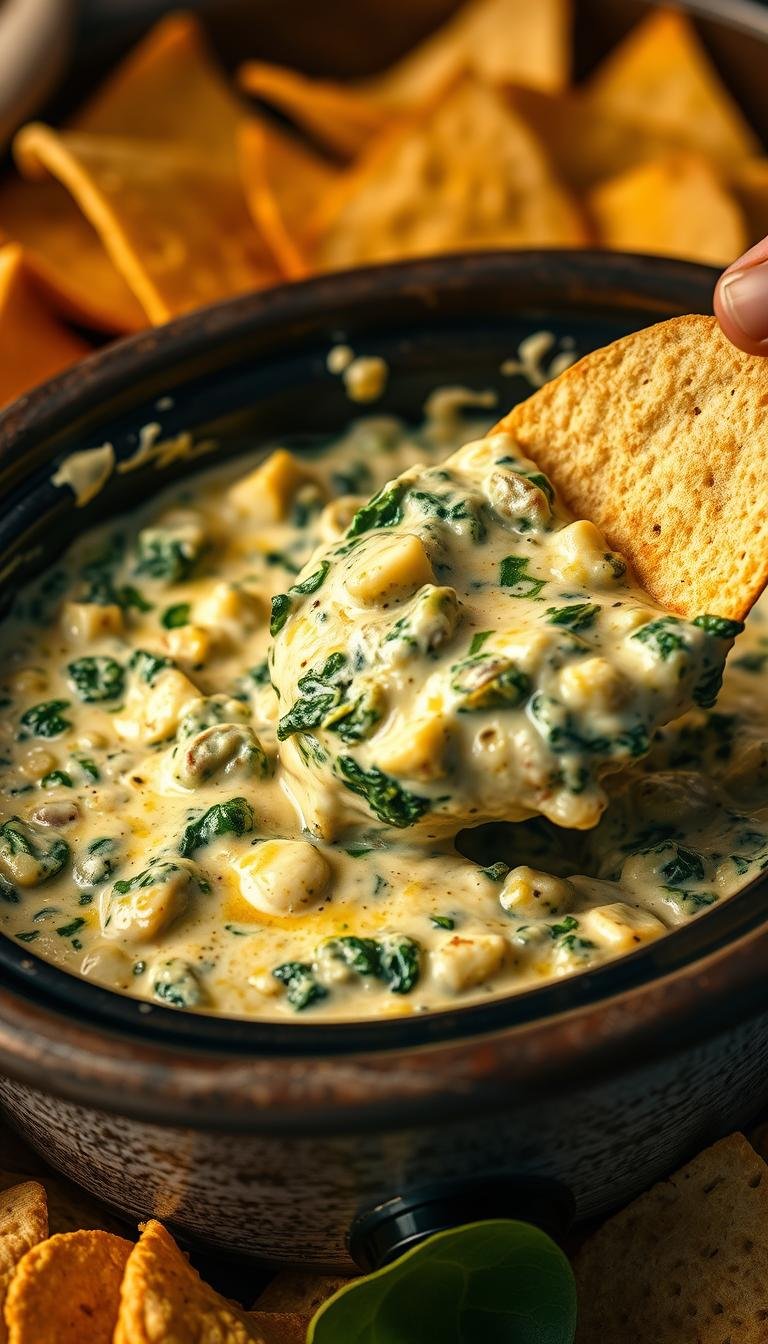3 Quick Tips on How to Make the Perfect Garlic Bread
Garlic bread, a staple in many cuisines, has been a crowd-pleaser for decades. With the rise of home cooking, more people are attempting to recreate this beloved dish in their own kitchens. However, achieving that perfect garlic bread can be challenging.
Did you know that the key to making great garlic bread lies not just in the ingredients, but in the technique? Using high-quality ingredients like fresh garlic and real butter can elevate your garlic bread to the next level. The right balance of flavors is crucial, and it’s what separates a good garlic bread from a great one.
Creating homemade garlic bread that’s crispy on the outside and soft on the inside is a skill worth mastering. With a few simple tips, you can transform your garlic bread game and impress your family and friends with a delicious, restaurant-quality garlic bread recipe.
Key Takeaways
- Use high-quality ingredients for the best flavor.
- Balance the flavors to achieve the perfect taste.
- Master the technique for a crispy outside and soft inside.
- Experiment with different garlic bread recipes to find your favorite.
- Pay attention to the quality of your garlic and butter.
The Art and Science of Garlic Bread
The allure of garlic bread lies not just in its flavor, but in its fascinating journey through time and cultures. Garlic bread has become a staple in many cuisines around the world, but its evolution and significance are often overlooked.
A Brief History of Garlic Bread
Garlic bread has its roots in ancient Mediterranean cuisine, where garlic was a fundamental ingredient. The concept of spreading garlic on bread dates back to ancient Rome and Greece, where people would use bread as a utensil to scoop up various mixtures, including those containing garlic.
The modern version of garlic bread, however, is often attributed to Italian cuisine, particularly to the Italian-American community in the United States. They popularized garlic bread as we know it today, typically using Italian bread, butter or margarine, garlic, and sometimes cheese.
Key historical milestones include:
- Ancient Rome and Greece: Early forms of garlic bread.
- 15th century Italy: Bread and garlic combinations became more sophisticated.
- 20th century United States: Italian-American cuisine popularized garlic bread.
Why Homemade Garlic Bread Trumps Store-Bought
Homemade garlic bread offers several advantages over store-bought varieties. The most significant difference lies in the flavor and texture, which can be customized according to personal preferences when made at home.
Homemade garlic bread allows for the use of fresh, high-quality ingredients, ensuring a more vibrant and satisfying taste experience. Additionally, the process of making garlic bread from scratch can be therapeutic and rewarding.
Some benefits of homemade garlic bread include:
- Customization of ingredients and flavors.
- Control over the quality of ingredients used.
- The satisfaction of creating something delicious from scratch.
Essential Equipment for Perfect Garlic Bread
To make perfect garlic bread, certain equipment is essential. While the list is not exhaustive, having the right tools can significantly improve the outcome.
Essential equipment includes:
- A good quality baking sheet or pizza stone.
- A sharp knife for cutting bread.
- Mixing bowls for preparing garlic compound butter.
Optional equipment, such as a garlic press or a stand mixer, can also be useful. Investing in these tools can elevate your garlic bread-making experience and result in a more delicious final product.
Selecting the Right Ingredients
The foundation of exceptional garlic bread lies in the quality of its ingredients. When it comes to creating garlic bread that impresses, the selection of ingredients is not just about throwing together some bread, garlic, and butter; it’s about making informed choices that elevate the final product.
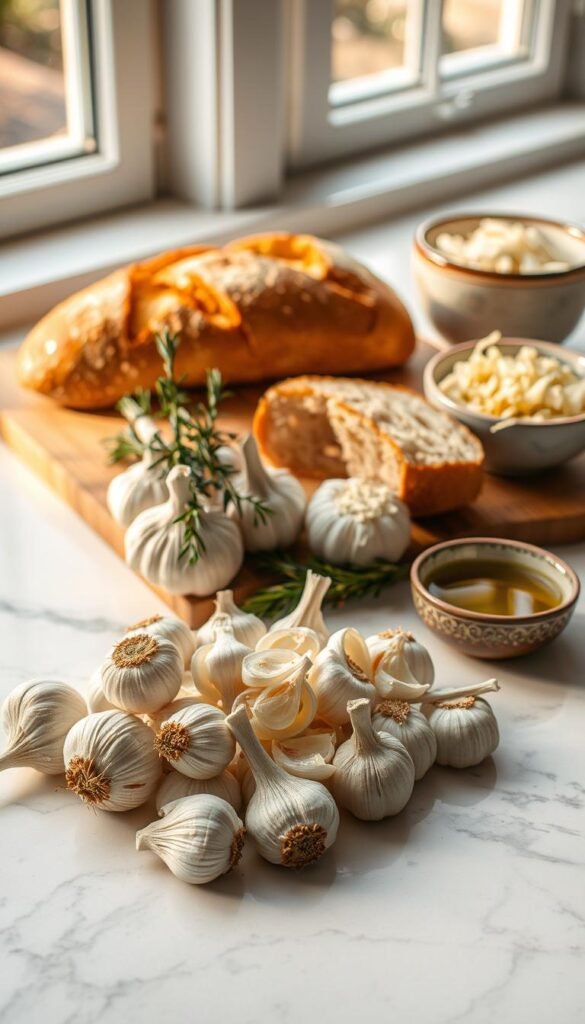
Choosing the Perfect Bread Base
Selecting the right bread is crucial for garlic bread. Options like French baguette, Italian loaf, ciabatta, and sourdough each bring unique characteristics to the table. The French baguette, with its crispy crust and soft interior, is a classic choice. The Italian loaf offers a slightly denser texture, while ciabatta provides a lighter, airier base. Sourdough, with its tangy flavor, adds a layer of complexity.
The structure of the bread, including crust thickness and crumb density, significantly affects the final product. A bread with the right balance between crust and crumb will yield a garlic bread that’s both crispy and soft.
Butter vs. Olive Oil: The Great Debate
The choice between butter and olive oil is a significant one. Butter brings a rich, creamy flavor and a golden-brown crust, while olive oil offers a lighter, more nuanced taste with a potential for a crisper crust. The decision between the two can depend on regional preferences and the desired flavor profile.
For a classic garlic bread, butter is often the preferred choice due to its flavor and browning properties. However, olive oil can be an excellent alternative for those looking for a lighter taste or a different texture.
Fresh Garlic vs. Garlic Powder
The debate between fresh garlic and garlic powder centers around flavor intensity and convenience. Fresh garlic provides a pungent, vibrant flavor, while garlic powder offers a more subtle, consistent taste.
Fresh garlic is ideal for those seeking a robust garlic flavor, while garlic powder is convenient and easier to store. The choice between them depends on personal preference and the specific application.
Herbs and Seasonings That Elevate Your Garlic Bread
Beyond the basics, herbs and seasonings can significantly elevate garlic bread. Classic additions include parsley and oregano, while less common options like rosemary, thyme, and red pepper flakes can add unique dimensions. Even a sprinkle of Parmesan cheese can enhance the flavor.
Experimenting with different combinations can help you find the perfect flavor profile for your garlic bread.
Tip 1: Master the Garlic-Butter Ratio
The foundation of great garlic bread is built on the precise balance of garlic and butter, a ratio that transforms a simple loaf into a culinary masterpiece. Achieving this balance is crucial for creating a dish that is neither overpowering nor bland. In this section, we’ll explore the intricacies of the garlic-butter ratio and how to apply it effectively.
The Golden Ratio Formula
For a standard loaf of garlic bread, a commonly recommended ratio is approximately 2-3 cloves of garlic per 4 tablespoons of butter. This formula provides a balanced flavor profile that enhances the bread without overwhelming it. However, the ideal ratio can vary based on personal preference and the type of bread being used.
Measuring Techniques for Consistency
To ensure consistency in your garlic bread, it’s essential to measure both garlic and butter accurately. While volume measurements are common, using weight measurements can provide more precise results, as the density of garlic and butter can vary. For garlic, mincing or crushing the cloves before measuring can also impact the flavor intensity.
Adjusting for Different Bread Types
Different types of bread absorb butter and distribute garlic flavor differently. For instance, denser breads like baguettes may require a slightly different ratio compared to lighter, airier breads. Understanding these nuances allows for adjustments to be made, ensuring that the garlic bread turns out perfectly regardless of the bread type.
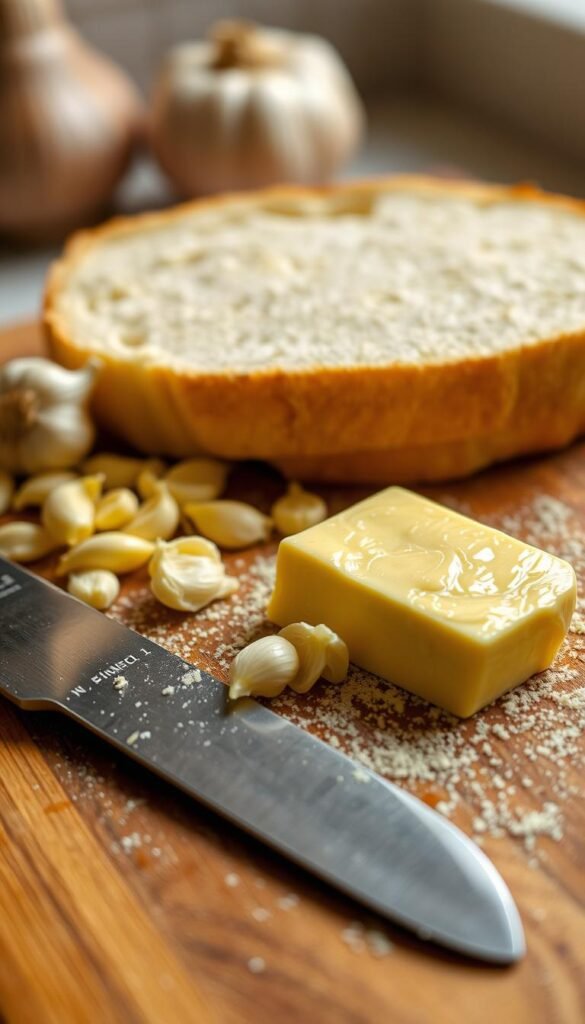
Infusing Butter with Garlic Flavor
Infusing butter with garlic is a critical step in creating rich, aromatic garlic bread. There are two primary methods for infusing butter: hot infusion and cold infusion.
Hot Infusion Method
The hot infusion method involves gently heating the butter with minced garlic until the garlic is fragrant and the butter is infused with its flavor. This method is quick and effective, providing a robust garlic flavor.
Cold Infusion Method
The cold infusion method requires mixing minced garlic into softened butter and letting it sit for a period of time, allowing the flavors to meld together. This method results in a more subtle, complex garlic flavor that is evenly distributed throughout the butter.
Common Ratio Mistakes to Avoid
Common mistakes when preparing garlic bread include using too much garlic, which can create bitterness, and insufficient butter, leading to dry bread. Proper mixing techniques are also crucial to avoid uneven distribution of garlic flavor. Being aware of these potential pitfalls can help in creating a perfectly balanced garlic bread.
Tip 2: Perfect Your Baking Technique
Mastering the art of baking garlic bread is crucial for achieving that perfect golden crust and flavorful interior. The baking technique is a critical step that can elevate your garlic bread from good to great.
Temperature and Timing Secrets
The right temperature and timing are essential for baking perfect garlic bread. Preheating your oven to the correct temperature is crucial, with most recipes recommending between 375°F to 400°F for standard baking. Convection ovens may require adjustments, typically a reduction of 25°F to 50°F.
Temperature Control: The temperature affects both browning and moisture retention. A higher temperature can lead to quicker browning but risks drying out the bread if not monitored. Conversely, a lower temperature may result in a softer crust but could lack the desired golden color.
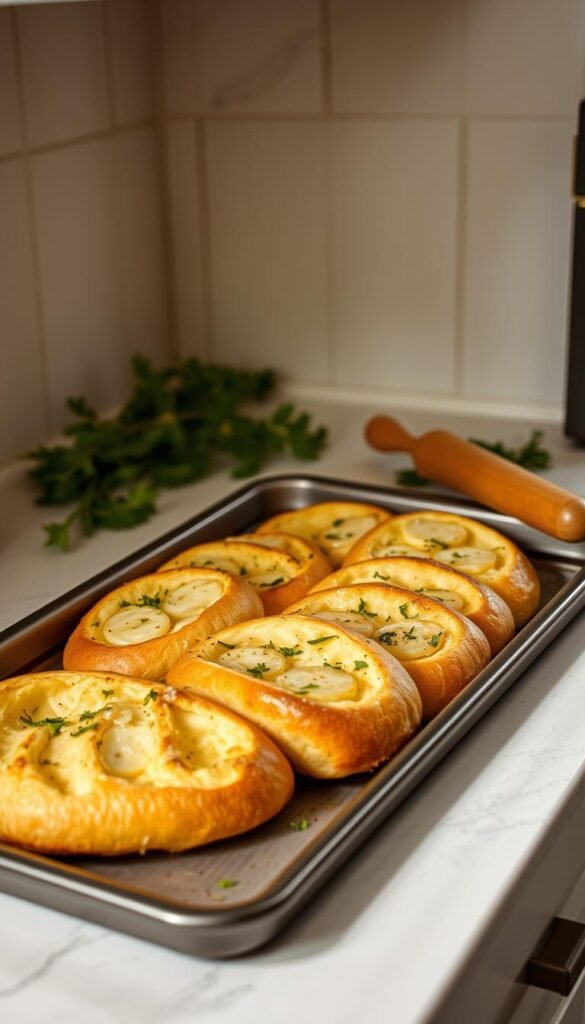
Proper oven positioning is vital for achieving even browning. The rack position can significantly impact the baking outcome. For most garlic bread recipes, placing the bread on the middle rack is recommended. However, for bread with a high topping or a particularly crusty loaf, positioning it on the upper third of the oven can enhance browning.
Visual Cues for Perfect Doneness
Understanding the visual cues for doneness is key to baking perfect garlic bread. The bread should be golden brown, with the edges slightly darker than the center. The crust should be crispy and firm to the touch. For loaves with cheese, a melted and bubbly top is a good indicator of doneness.
The Two-Stage Baking Method
The two-stage baking method is a foolproof technique for achieving the perfect balance of flavor development and texture. This method involves an initial covered baking phase followed by a final browning phase.
Initial Covered Baking Phase
During the initial phase, the garlic bread is baked covered, usually with foil, to trap moisture and heat. This step helps in evenly cooking the bread and infusing the flavors. The covering prevents the crust from browning too quickly, allowing the interior to cook thoroughly.
Final Browning Phase
In the final phase, the covering is removed, and the bread is allowed to brown. This step is crucial for developing the crust’s color and crispiness. The timing of this phase is critical; it should be long enough to achieve the desired browning but not so long that the bread burns.
Broiling vs. Baking: When to Use Each
Both broiling and baking have their places in garlic bread preparation. Baking is generally used for cooking the bread through and developing a crust. Broiling, on the other hand, is often used as a final step to add a crispy top or melt cheese. Understanding when to use each method can significantly impact the final product.
Broiling can quickly add a golden-brown crust, but it requires close monitoring to prevent burning. Baking provides a more even cooking and is generally safer for achieving a well-cooked interior.
Tip 3: Achieve the Ideal Texture Balance
Achieving the perfect texture balance is crucial for elevating garlic bread from a simple snack to a culinary delight. The ideal garlic bread boasts a crispy crust giving way to a soft, airy interior – a contrast that enhances both the flavor and the overall eating experience.
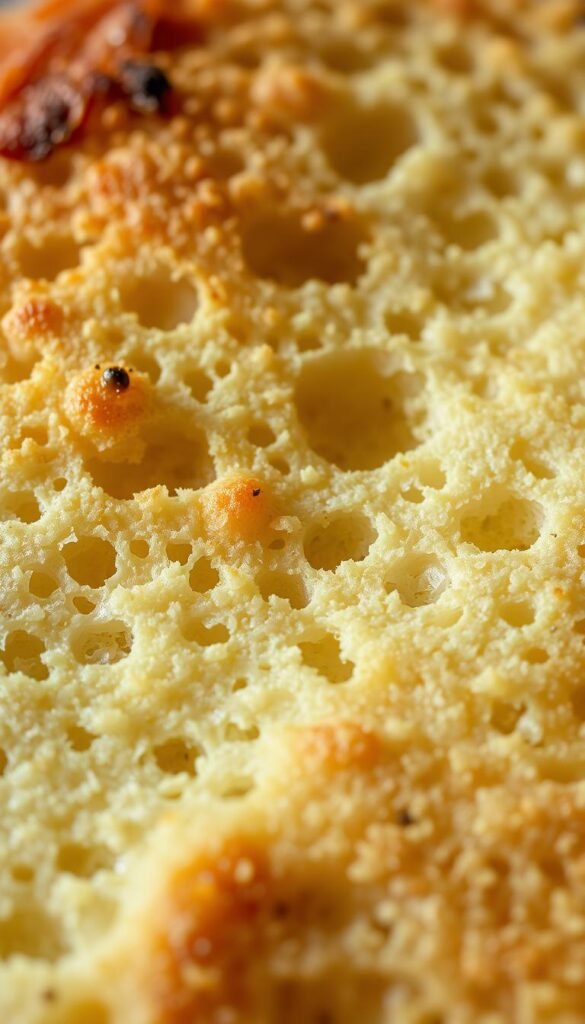
Creating the Crispy-Soft Contrast
The crispy-soft contrast in garlic bread is not just a matter of taste; it’s rooted in the science of baking. To achieve this contrast, it’s essential to understand the factors that contribute to both crust crispiness and interior softness.
Crust Development Techniques
Developing a crispy crust involves several techniques:
- Proper butter distribution to enhance browning
- Surface preparation, including scoring or slicing, to increase the surface area
- Temperature management during baking to optimize crust formation
By mastering these techniques, you can significantly improve the crust’s texture.
Maintaining Interior Softness
Maintaining a soft interior requires a different set of strategies:
- Selecting the right type of bread that retains moisture well
- Controlling the baking time and temperature to prevent overcooking
- Using the foil technique to regulate moisture loss during baking
These methods help in preserving the softness inside the garlic bread.
The Foil Technique for Moisture Control
The foil technique is a simple yet effective method for controlling moisture during the baking process. It involves covering the garlic bread with foil for a portion of the baking time to prevent excessive drying or browning.
When to Cover and Uncover
The timing of covering and uncovering the garlic bread with foil is crucial. Generally, covering the bread for the first half of the baking time helps retain moisture, while uncovering it for the second half allows for crust development.
Foil Tenting vs. Tight Wrapping
There are two primary methods of using foil: tenting and tight wrapping. Tenting allows for some airflow and browning, while tight wrapping traps more moisture. The choice between these methods depends on the desired texture and the type of bread being used.
Testing for Perfect Texture
Testing garlic bread for perfect texture involves a combination of visual, tactile, and auditory cues. A well-baked garlic bread should have a golden-brown crust, feel firm on the outside but yield to softness inside, and produce a satisfying crunch when broken.
By paying attention to these indicators, you can adjust your baking technique to achieve the ideal texture balance.
Garlic Bread Variations to Try
Take your garlic bread game to the next level with these innovative twists. Garlic bread is a versatile canvas waiting for your creative touch. Whether you’re in the mood for something cheesy, herby, or internationally inspired, we’ve got you covered.
Cheesy Garlic Bread Upgrades
Cheese can elevate garlic bread to a whole new level. Experiment with different types of cheese to find your perfect match. Mozzarella provides a creamy melt, while Parmesan adds a salty, nutty flavor. You can also try Fontina for a mild, earthy taste or Gruyère for a rich, creamy texture.
When combining cheeses, start with a base cheese like mozzarella or fontina, and then add a secondary cheese like parmesan or gruyère for added depth. Timing is crucial; add cheese towards the end of baking to prevent burning. For an extra-golden crust, broil the garlic bread for a minute or two after adding the cheese.
Herb-Forward Variations
Herbs can add a fresh, aromatic flavor to your garlic bread. Try using rosemary and thyme for a Mediterranean twist, or parsley and dill for a brighter, fresher taste. When using fresh herbs, chop them finely and mix them into the garlic butter for an even distribution of flavor.
- Mix chopped fresh herbs into garlic butter
- Use dried herbs for a more subtle flavor
- Experiment with different herb combinations
International Twists on Classic Garlic Bread
Explore global flavors to give your garlic bread an international twist. For an Asian-inspired version, try adding sesame oil and scallions. For an Indian-influenced garlic bread, use ghee and curry spices. Latin American flavors like cilantro and lime can also add a zesty twist.
When experimenting with international flavors, start with small adjustments to the garlic butter, such as adding a spice or herb, and taste as you go. This will help you achieve the perfect balance of flavors.
Serving and Pairing Your Perfect Garlic Bread
Once you’ve mastered the art of making perfect garlic bread, the next step is to learn how to serve and pair it effectively. Garlic bread is a versatile side dish that can complement a variety of meals, and understanding how to pair it correctly can elevate your dining experience.
Classic Pairings That Never Fail
Garlic bread is a classic companion to many Italian dishes, particularly pasta. It pairs well with spaghetti Bolognese, lasagna, and chicken parmesan. The key to a successful pairing is to balance flavors: the richness of garlic bread complements the acidity in tomato-based sauces.
It’s also a great match for soups, especially creamy broths like tomato soup or French onion soup. For a lighter option, garlic bread can be served alongside green salads or as a side to grilled meats and roasted vegetables.
- Spaghetti Bolognese
- Lasagna
- Chicken Parmesan
- Tomato Soup
- French Onion Soup
- Green Salads
- Grilled Meats
- Roasted Vegetables
Presentation Tips for Impressive Serving
The presentation of garlic bread can greatly enhance its appeal. Consider slicing it into uniform pieces and arranging them on a serving platter or bread basket. For a more rustic look, serve it directly on a wooden cutting board.
Garnishing with fresh herbs like parsley or thyme can add a pop of color and freshness. For a more indulgent touch, top your garlic bread with melted cheese or a sprinkle of parmesan before serving.
Make-Ahead and Storage Tips
While garlic bread is best enjoyed fresh, there are ways to prepare it ahead of time. You can prepare the garlic butter compound in advance and store it in the refrigerator for up to a week or freeze it for longer storage.
To store leftover garlic bread, cool it completely before wrapping it tightly in foil or plastic wrap. It can be refrigerated for up to 3 days or frozen for up to 2 months. To reheat, simply bake it in the oven until crispy.
- Cool garlic bread completely before storing.
- Wrap tightly in foil or plastic wrap.
- Refrigerate for up to 3 days or freeze for up to 2 months.
- Reheat in the oven until crispy.
Troubleshooting Common Garlic Bread Problems
Garlic bread, a simple yet nuanced culinary delight, often presents a few common challenges that can be easily overcome with the right techniques. Whether you’re a seasoned baker or a novice in the kitchen, understanding how to address these issues can elevate your garlic bread game.
Fixing Soggy Garlic Bread
Soggy garlic bread is often the result of excessive butter, insufficient baking time, or improper cooling. To fix this, try re-baking the bread at a low temperature (around 300°F) for a few minutes to crisp it up. Alternatively, you can try toasting the bread to give it a crunchy texture.
- Check your butter-to-bread ratio to avoid over-saturation.
- Ensure you’re baking the bread long enough to crisp the outside.
- Cool the bread properly on a wire rack to prevent moisture buildup.
Remedies for Burnt Garlic Bread
Burnt garlic bread can be salvaged if caught early. For slightly burnt bread, you can try selectively trimming the burnt parts or repurposing it into croutons or breadcrumbs. To prevent burning, use a timer and monitor the bread’s progress, especially when baking at high temperatures.
- Keep an eye on your garlic bread while it’s baking, as the line between perfectly toasted and burnt can be thin.
- Use a lower oven temperature to prevent burning, especially if you’re new to baking garlic bread.
Balancing Overpowering Garlic Flavor
If your garlic bread tastes too garlicky, there are a few remedies you can try. You can dilute the flavor by adding more bread or butter, or balance it out with complementary ingredients like herbs or cheese. For future batches, adjust the amount of garlic used or try roasting the garlic first to mellow its flavor.
- Roast your garlic before mincing it to reduce its pungency.
- Add a sprinkle of parmesan or other cheese to balance out the garlic flavor.
Conclusion
Mastering the art of garlic bread involves understanding the delicate balance between ingredients, technique, and presentation. By applying the three key tips outlined in this article – mastering the garlic-butter ratio, perfecting baking techniques, and achieving the ideal texture balance – you’ll be well on your way to creating a perfect garlic bread recipe that delights family and friends.
Homemade garlic bread tips reveal that the secret to consistently excellent results lies in the harmony between these elements. Whether you’re using a classic recipe or experimenting with cheesy garlic bread upgrades or herb-forward variations, the fundamental principles remain the same. Garlic bread techniques, such as the two-stage baking method and foil technique for moisture control, will help you achieve a crispy exterior and soft interior.
As you continue to refine your garlic bread recipe, remember that practice makes perfect. Don’t be afraid to experiment with different ingredients and techniques to develop your signature style. The joy of sharing homemade garlic bread with others is a culinary experience worth celebrating, and with these tips, you’ll be well-equipped to create delicious garlic bread that brings people together.


